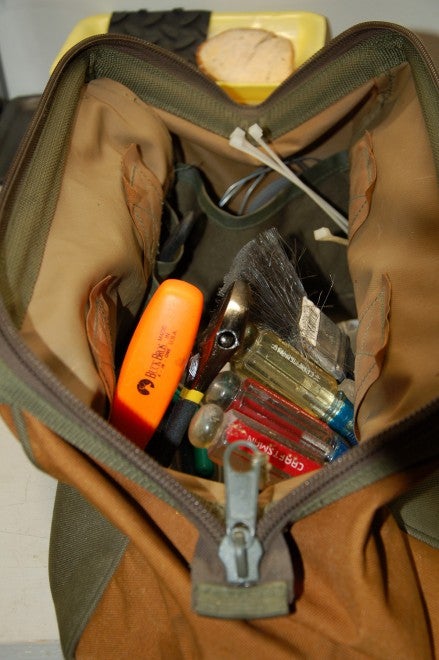Grab Bag Tool Kit
Dr. John Woods 04.05.16

As a general rule, preppers and survivalists have learned to be minimalists. They know that if and when a true SHTF comes, that they will not be able to grab and haul everything they have with them on a bug out scenario. Hence the basic principles of bug out bags and preparing secondary caches and alternative locations to go to.
One of the most basic kits or bags every prepper needs to have already assembled is a small bag full of a dozen or so basic tools and fix-it supplies. This can be put together now and placed either in your primary vehicle or just inside the garage or back door at the house to “grab” up on the way out.
The point being here that no matter what you do or where you go, things are going to need to be fixed, maintained, changed out, or modified. This takes a minimum of hand tools to complete the jobs that might come up. How many times a day, week, or month are you going to the house tool box to find a tool to fix something? The need for tools is no debate.
So, what do you put into a small hand tool bag (or any type of heavier cloth bag or satchel) to be able to have some basic tools on hand to fix things? Here is a preview of recommended tools to have in the kit. You may suggest or what other tools or supplies as well.
Pliers: There is no particular order of tools to list, so start with a good pair of steel pliers of medium size. These can hold things, twist things, turn nuts or bolts, screws, pull nails, and be used as a mini-vise. Rubber gripped ones are nice for a secure hold.
Screwdrivers: Have at least one flat head and one Phillips screwdriver in the kit, but of course, several sizes would be better. Buy ones with good secure handles and of high enough quality that the heads don’t twist out of shape the first time you use one.
Adjustable Wrenches: Have at least one size 10 or 12 adjustable wrench. These can be used for loosening or tightening all kinds of nuts and bolts. The adjustable wheel makes the open end wrench fit the job exactly for good torque and a firm hold. A wrench with at least a ¾ inch maximum opening should handle most jobs.
Blade Cutter Knife: A good pocketknife cannot be replaced, but every tool kit needs to have a razor type box cutter knife for all kinds of general cutting work. These can cut everything from string to tape to radiator hoses, garden hose, cardboard, sheet rock or whatever. The types with the break off edges are good so a fresh cutting edge can be applied to the job. The blade should also be retractable for safety.
Claw hammer: The claw hammer is basic for pounding and extracting. Of course you can hammer nails or pull them, but sometimes other things need some purposeful persuasion with a little tapping or thumping. A good rubber handled hammer is good for coaxing all sorts of things into place or out of it. The claw end can be used to pry things apart, too.
Slip Joint Pliers: These are different from standard type pliers in that the head opens much wider to variable adjustment widths by sliding the handle grooves apart. Again, these are pliers so they can hold things or grip things that are much bigger like plastic pipe, hoses, and larger parts and such. Slip joint pliers are very useful.
Vise-Grips: This is a somewhat unique tool with jaw widths that are adjusted by screwing the handle knob in or out to widen the gap in the grip head. Then a closing snap handle locks the grips like a vise around the item being worked on. These are good for holding various parts to work on or stabilize things while assembling or taking apart.
Saws: Though bigger than a small kit bag, consider a small hack saw or a handsaw that changes out types of blades for metal and wood. Even a small, folding, hunter-type saw would be helpful.
Tape: At the very least have a big roll of duct tape. This universal hold tight fix nearly everything tape is essential. Duct tape can fix leaks, hold things together, lash items tight, or patch holes and fix a hundred other things. Also have a roll of black electrical tape for a multitude of uses. Add some masking tape, but it is the least essential.
What else would you add? I can certainly think of many other items, including files, punches, chisels, sockets, and wrenches, Allen wrenches, clamps, other saws, a bag of nails and screws, tape measure, glue, WD-40 or another oil, hand cleaner, and some shop towels. Let us see your list.